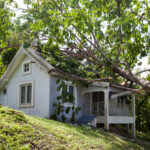
Finding a fallen tree is a harrowing experience, especially if it causes damage to your home or car or hurts someone you love. In the aftermath, you’re probably left wondering who is responsible for the associated costs and how to get compensation to cover them.
In California, the answers to these questions depend on the circumstances surrounding the incident. There are some generalities you should know, however, if your life was turned upside-down by a fallen tree caused by the storms that have been lashing the state lately.
Who May Be Liable for Damage Caused by a Fallen Tree?
If a fallen tree has damaged your property, you may be able to recover compensation from the owner of the land where the tree was growing before it fell. This could be a private homeowner, a business owner, or the local government, depending on the circumstances.
In California, property owners are responsible for maintaining their trees and removing any dead or dying branches that pose a risk to people and property. If a property owner fails to do this and a falling branch causes damage, they may be liable for the damages.
If the tree was on your land and the incident is considered a covered event under the terms of your insurance policy, you may be able to file a claim with your own carrier. Homeowners insurance generally covers structural damage, as well as any damage to the possessions that were inside the building at the time. Renters insurance can also cover damage to personal property, while auto insurance covers vehicular damage.
This is assuming, however, that the tree fell due to a windstorm, lightning, or hail. A standard policy does not typically cover damage caused by trees that fall due to earthquakes, floods, and mudslides.
What Kinds of Factors May Affect Liability?
Assigning blame for the damage caused by a falling tree is challenging, and several factors can affect the outcome of a case. These include:
- The Cause of the Fall: If the branch fell due to natural causes, such as a storm or high winds, it may be difficult to hold the property owner or local government liable. If, however, the branch fell due to neglect or lack of maintenance, liability may be easier to establish.
- The Location of the Tree: If the tree was growing on private property, the property owner might be responsible for the damage. If the tree was growing in a public space, such as a park or sidewalk, the local government may be liable.
- The Terms of the Property Owner’s Insurance Coverage: As mentioned above, standard insurance policies don’t usually cover damage caused by trees that fall during earthquakes, floods, or mudslides. If an uncovered event is to blame for the uprooting, assigning blame to anyone will pose a challenge.
Speak with a Long Beach Personal Injury Attorney
Your Injuries Are Personal to Me
If a fallen tree has turned your life upside-down and you’re unsure how to proceed, turn to the Law Office of Michael D. Waks. Attorney Waks has been representing the injured and their families for more than 38 years. Call (562) 206-1939 or fill out the Contact Form on our website to schedule a free initial consultation with a personal injury lawyer in Long Beach.
- Motorcycle Helmet Laws and Injury Claims in Los Angeles - October 15, 2025
- What Liability Waivers Mean for So Cal Injury Cases - October 8, 2025
- Proving Psychological Injuries in Long Beach Injury Cases - October 1, 2025